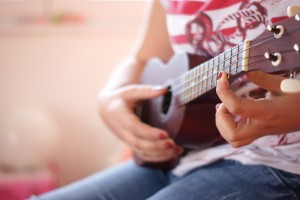In a perfect world, who should have access to the arts? Among artists, arts administrators, and arts educators the answer is likely to be unanimous: “Everyone!” And yet for the most part, that conviction is based on little more than gut instinct and personal experience. Do we actually have any evidence that people are happier with their lives for having art in it?
Those of you who read Createquity’s recent article on television and wellbeing might have noticed an interesting tidbit: according to our analysis of data from the 2012 General Social Survey, there is no relationship between having attended an exhibit or performance in the past year and one’s satisfaction with life, after controlling for factors such as health and income. Left unexplored by that analysis, however, was the question of more active forms of participation – i.e., creation and performance. Enter “Artful Living,” a recent paper from Vanderbilt University’s Curb Center for Art, Enterprise, and Public Policy. Not only does the 2014 study reveal a positive correlation between several forms of active participation and life satisfaction (which some scientists refer to as “subjective wellbeing”), it finds that some forms of art increase people’s wellbeing more than others, and that the arts improve some people’s lives more noticeably than others, too.
In “Artful Living,” Steven Tepper and his team examine the relationship between several creative pastimes and subjective wellbeing, and compare findings across demographic groups. The authors focus specifically on “artistic practice” (including activities such as playing a musical instrument and craft-making), rather than more passive forms of arts participation, such as attendance and reception.
Drawing on data from three national surveys, the researchers find a generally positive relationship between maintaining an artistic practice and various measures of subjective wellbeing. For instance, using a dataset of over 20,000 responses to the DDB Needham Life Style Survey of consumer attitudes in the U.S., the authors find that all three of the artistic practices examined (playing a musical instrument, gardening, and craft-making) are all positively associated with life satisfaction. Moreover, life satisfaction increases with greater frequency of participation in any of these activities. While the relationships are positive across the board, there are considerable differences between those three practices: the wellbeing gains associated with playing an instrument are almost twice as large as those for craft-making.
Besides the differences across artistic practices, the researchers observe that these positive correlations are more pronounced among women and people of color than their male and white counterparts. The relationships are particularly strong for women engaged in craft-making and gardening and people of color who either play an instrument or garden. The authors theorize that this might be attributed to certain benefits of artistic practice like self-expression and a greater sense of personal control and efficacy, which might be particularly helpful for improving the wellbeing of historically marginalized groups.
In addition to the DDB data, the Curb Center researchers analyzed data from a survey of 1,700 college seniors at nine institutions (the Double Major Student Survey) and from the Strategic National Arts Alumni Project (SNAAP), which surveyed slightly more than 4,000 graduates from 76 art colleges. The results from the Double Major Student Survey lead the authors to conclude that students who engage in arts activities have a more positive self-image and social outlook. The SNAAP data indicates higher levels of life satisfaction among former arts students who have continued their artistic practice, but only among those who feel that they have adequate time to practice their art. Those who continue to create art but feel they don’t have enough time to do so report lower levels of life satisfaction than arts graduates who gave up their creative work entirely.
While these findings are intriguing, it is difficult to say how meaningful these associations are, as the effect sizes are fairly small. The developed models include variables such as age, race, gender, income, employment status, and marital status, plus data on respondents’ artistic practice. All of these variables together only explain about 8 to 13 percent of respondents’ subjective wellbeing.
The authors try to contextualize the size of the wellbeing increases associated with an artistic practice by stating that the increases are comparable to or greater than those that result from being married or having children. That seems pretty impressive at first glance, until one thinks about the fact that over 30 percent of marriages end in divorce, and that spending quality time with a crying newborn at 2am is a decidedly mixed blessing. It turns out that the ups and downs of these life-changing events are reflected in wellbeing surveys: the impact of marriage on wellbeing is fairly mixed, and while individual studies have conflicting results, it seems like levels of life satisfaction generally aren’t so different for parents and non-parents.
A more helpful point of comparison is provided in a study that compares the wellbeing impacts of sports and cultural engagement in the U.K., which came out the same year as “Artful Living.” As in “Artful Living,” the British researchers found a positive, statistically-significant relationship between artistic endeavors and life satisfaction. However, the increase in life satisfaction associated with arts engagement is slightly lower than that of participation in sports. This certainly isn’t the final word on the subject, but it demonstrates how comparisons can be used to make the effect sizes intelligible.
Even with these caveats, “Artful Living” serves as a great example of exploratory work demonstrating the relationship between the arts and wellbeing in the U.S. It also gives us valuable insight into the varying effects of artistic practice on different populations. As always, additional research would be useful. While experimental methods would be desirable, incorporating more forms of artistic practice within a general population survey like the DDB Needham Lifestyle Survey might be an excellent first start. In the meantime, “Artful Living” is notable for taking the challenge of measuring the wellbeing impact of the arts head on, and lays a helpful foundation for future research.
